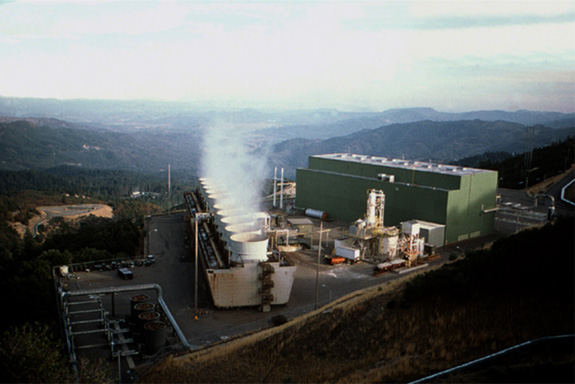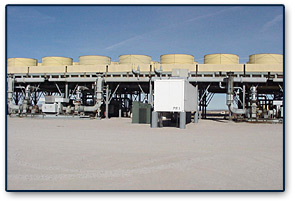Archive for December, 2007
Best Geothermal Reference

An associate recently referred a text book to our attention: Geothermal Power Plants: Principles, Applications, and Case Studies. (A second edition is due to be released this month.)
Have you ever wanted to understand or model hydrothermal reservoir characteristics? Have you ever wanted to simply grok what a hydrothermal reservoir is? Would you like to be able to model/understand the thermodynamic characteristics of a hybrid flash-binary geothermal harvest system? Would you like to know where geothermal plants are installed, their conversion method, and capacity? If you answered yes to any of these questions, then this is the book for you.
DiPippo does an admirable job in making the material accessible to all, yet including the deep technical details and formulae required to perform analysis of geothermal projects.
Multi-dimensional harvest experiment
Northern California Power Agency (NCPA) and SPG Solar, announced that they will together to build a 1 megawatt (MW) single-axis solar tracking system that will provide renewable energy to an existing pump station that supplies the NCPA Geysers Geothermal Energy Plant.
The array will be used to collect solar power to pump wastewater into the geysers, which is in turn used to generate geothermal power. The photovoltaic array will start generating clean renewable power beginning in September 2008.
The $8.2 million installation consists of 6,300 solar modules that will produce 2.2 million kilowatt hours of electricity annually. The solar plant will supplant PG&E-provided grid power that had been powering the pumps.
NCPA operates two geothermal plants at the Geysers producing approximately 132MW gross, and 120MW net of electricity. In the late 1990’s, in an attempt to regain pressure in the rapidly declining Geysers field, NCPA and other operators at the Geysers entered into an agreement with Lake County to reclaim the treated waste water, pipe it to the Geysers, and reinject it into the reservoir. This is necessary because nearly 70% of the mass extracted from the reservoir is released into the atmosphere during operations of the power plants and natural recharge was not matching the pace of extraction.

The good news is this scheme to replace mined mass has worked; so much so, that Calpine followed suit and created a similar agreement with Santa Rosa. The bad news is, it takes power to move the millions of gallons of water from Lake County to the injection wells. The pipeline is about 30 miles (50 km) and gains nearly 2,000 feet (600 m) in elevation over the course of its run. The load to run the pipeline operations is about 8MW, or two-thirds of the parasitic load borne by the NCPA plants.
So, in practical terms, the application of solar energy to power some of the pumping operations should be characterized as an experiment in multi-dimensional harvest. The other opportunities NCPA and the other Geysers operators have (given the location and transmission infrastructure) are straight-forward bottom cycling using the new generation units from UTC power further harvesting heat from the steam exhaust from the turbines and wind turbine installation. This is the approach Montara Energy Ventures is taking with its Sou Hills Prospect.
Geothermal Library
The Geothermal Resources Council has recently made a new resource available for its members. The organization has taken over 3,000 technical articles produced in the GRC Transactions and Special Reports and posted them in a research library. This will be an incredibly valuable resource to those interested in geothermal electricity production.
Access the GRC Research Library.
For no particular reason, here’s a photo of a geothermal plant. Enjoy!

Geothermal Development and Finance Workshop
The Geothermal Energy Association, a group that is effectively the geothermal industry’s lobby in Washington, D.C., is sponsoring another Development and Finance Workshop. We’ve attended two of these and can say, for people trying to break into geothermal, they’re a value-added event. Also, like all of these events, it’s proven to be an excellent networking opportunity. This one will be in Las Vegas at the Bally Hotel, Wednesday, January 16, 2008. The session runs from 8-5 and a reception follows.
Session Topics:
- The outlook for state renewable energy laws, federal tax incentives, and other key incentives for expanding geothermal energy production in the West.
- New avenues for financial support of geothermal projects – green power, climate credits, and other approaches.
- Geothermal investing from a variety of viewpoints, including the financing, investing, and marketing of new projects.
- Geothermal project development basics from leading project developers.
- New projects under development: what, where and by whom.
- Geothermal resources in the West – overview and key issues to address for development
So, if you’re interested in geothermal project development and you’d like to get a jump start, we recommend attending this workshop.
Comments are off for this post
House passes Energy Bill, again
Via CNN:
The House of Representatives passed the first major increase in fuel economy standards in more than 30 years with a 235-181 vote. The energy bill requires automakers to raise their average fuel economy standard by 40 percent to 35 miles per gallon by 2020. The current standard — 27.5 mpg for cars and 22.2 for trucks –was passed in 1975.
…
The bill also includes a mandate that electric utility companies generate 15 percent of their energy from renewable sources of energy such as wind, biomass or solar power by 2020. Rep. Joe Barton, R-Texas, argued the “renewable energy standard” leaves out some technologies like clean coal and hydrogen, and is “almost impossible to meet” by most states.
While not reported in this story, the bill also extends production tax credits until 2012, which will stimulate renewable power project development as it reduces the risk to finance these projects. The Senate will likely approve the bill and it will then face a veto by lame-duck President Bush.
1 comment








